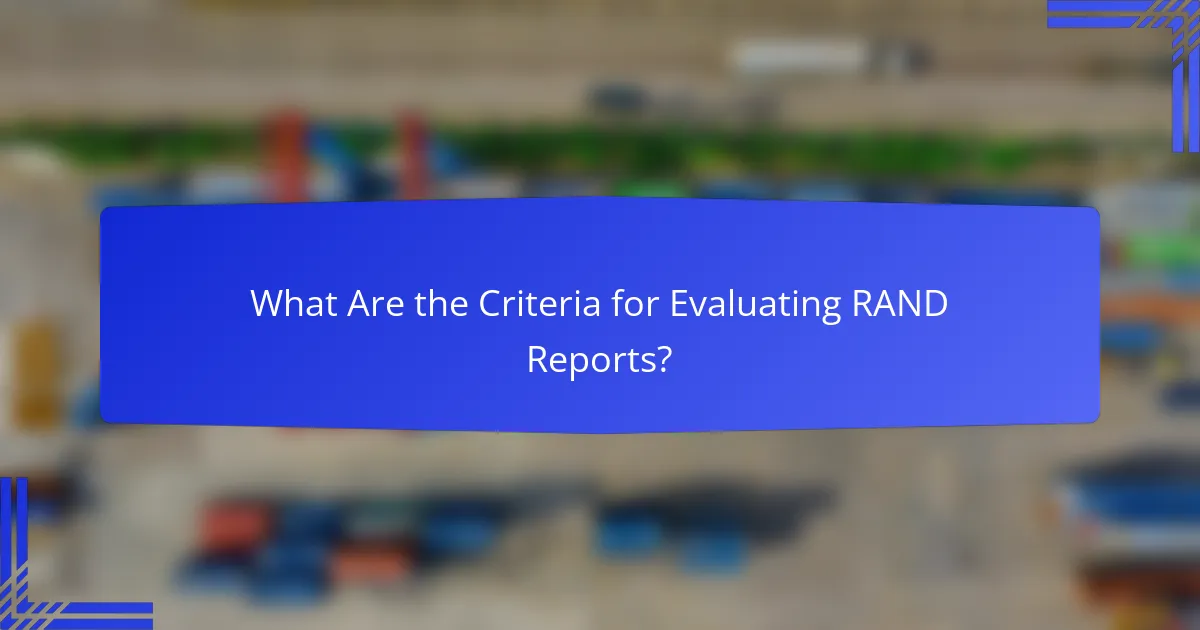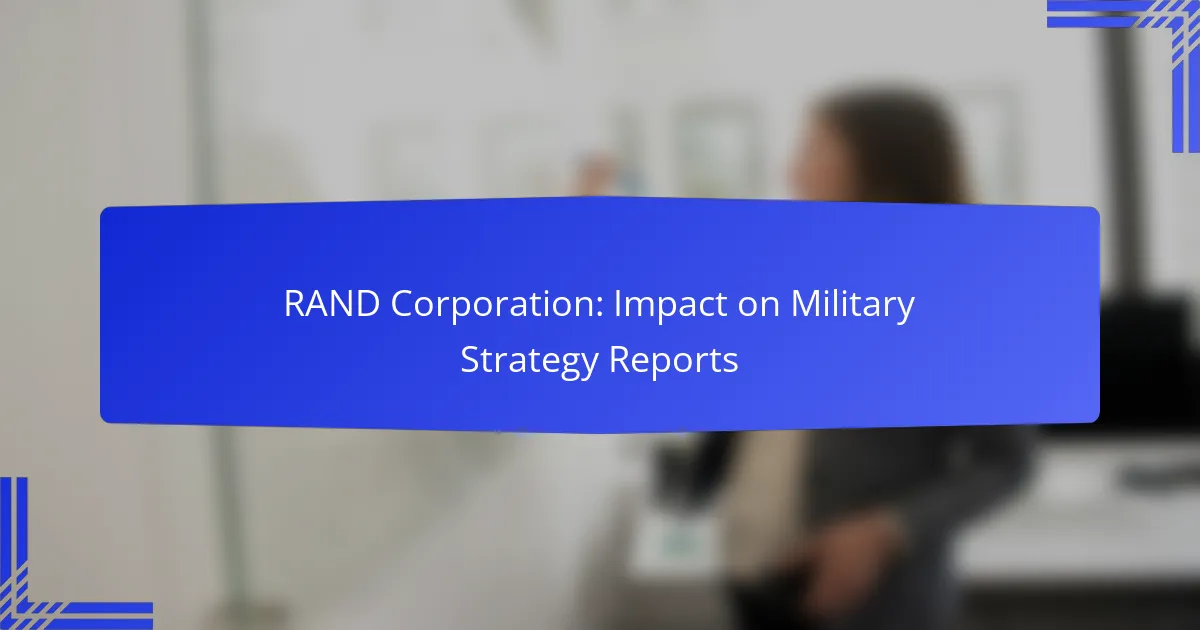The RAND Corporation plays a crucial role in shaping military strategy through its extensive research and analysis. By providing evidence-based insights and strategic frameworks, RAND’s reports equip military leaders with the knowledge needed to navigate current trends, assess risks, and formulate effective strategies for future conflicts.

How Does RAND Corporation Influence Military Strategy?
RAND Corporation significantly impacts military strategy through comprehensive research, analysis, and policy recommendations. Their work informs defense planning and operational effectiveness by providing evidence-based insights and strategic frameworks.
Research and Analysis Contributions
RAND Corporation conducts extensive research on military capabilities, threats, and operational strategies. Their analytical models help military leaders understand complex scenarios and assess potential outcomes of various strategies. For example, they utilize simulations to evaluate the effectiveness of different force deployments in conflict situations.
Additionally, RAND’s publications often include quantitative assessments of military readiness and resource allocation, guiding decision-makers in optimizing defense budgets and personnel assignments. This research is crucial for adapting to evolving geopolitical landscapes.
Policy Recommendations
RAND provides actionable policy recommendations aimed at enhancing military effectiveness and resilience. Their experts analyze current military policies and suggest improvements based on empirical data and strategic foresight. For instance, they may recommend shifts in defense spending priorities to address emerging threats or technological advancements.
These recommendations often emphasize collaboration between military branches and allied nations, ensuring a unified approach to global security challenges. By advocating for specific policy changes, RAND helps shape defense strategies that are both pragmatic and forward-thinking.
Case Studies on Military Operations
RAND’s case studies on military operations offer valuable lessons learned from past conflicts. They analyze successes and failures in various military engagements, providing insights into effective tactics and strategies. For example, their examination of recent conflicts may highlight the importance of intelligence sharing and joint operations among allied forces.
These case studies serve as practical guides for military planners, illustrating how historical precedents can inform current and future operations. By learning from previous experiences, military leaders can make more informed decisions in high-stakes environments.

What Key Reports Shape Military Strategy?
Key reports from the RAND Corporation significantly influence military strategy by providing comprehensive analyses and recommendations based on research and data. These reports help military leaders understand current trends, assess risks, and develop effective strategies for future conflicts.
Military Strategy in the 21st Century
Military strategy in the 21st century is characterized by rapid technological advancements and shifting geopolitical landscapes. Reports emphasize the importance of adapting to hybrid warfare, which combines conventional and unconventional tactics, and the need for agile responses to emerging threats.
Strategic frameworks now focus on integrating cyber capabilities, intelligence operations, and coalition-building among allies. For instance, the U.S. military’s emphasis on joint operations reflects the necessity of collaboration across different branches and international partners.
Assessing Global Military Trends
Assessing global military trends involves analyzing various factors such as military spending, troop deployments, and emerging technologies. RAND reports often highlight the rise of non-state actors and the increasing importance of cyber warfare in shaping military engagements.
Countries are investing heavily in advanced technologies like artificial intelligence and unmanned systems, which are reshaping traditional military capabilities. Understanding these trends helps military strategists anticipate potential conflicts and allocate resources effectively.
Innovations in Warfare
Innovations in warfare are transforming how conflicts are conducted, with a focus on technology-driven solutions. Reports detail advancements in drone warfare, autonomous systems, and cyber capabilities that enhance operational effectiveness and reduce risks to personnel.
For example, the use of drones for surveillance and targeted strikes has become a critical component of modern military operations. Additionally, integrating artificial intelligence into decision-making processes can improve response times and situational awareness on the battlefield.

How Are RAND’s Findings Applied in the Military?
RAND’s findings are integrated into military operations through comprehensive analysis and strategic recommendations that inform defense policies and practices. These insights help shape various aspects of military planning, training, and decision-making processes.
Integration into Defense Planning
RAND’s research plays a crucial role in defense planning by providing evidence-based assessments of military capabilities and threats. This integration helps military leaders prioritize resources, develop budgets, and allocate personnel effectively.
For example, RAND studies may highlight the need for increased investment in cybersecurity or unmanned systems, guiding the Department of Defense in its strategic direction. By aligning military objectives with RAND’s findings, planners can create more robust defense strategies.
Training and Simulation Programs
Training and simulation programs in the military often incorporate RAND’s research to enhance realism and effectiveness. These programs utilize findings to develop scenarios that reflect current and emerging threats, ensuring that personnel are well-prepared for real-world challenges.
For instance, simulations based on RAND’s analyses can help troops practice responses to hybrid warfare or cyber attacks, improving their readiness. This approach ensures that training remains relevant and aligned with strategic goals.
Operational Decision-Making
Operational decision-making in the military is significantly influenced by RAND’s findings, which provide critical insights into tactical and strategic options. Military leaders use these insights to make informed choices during missions, enhancing the likelihood of success.
For example, RAND’s assessments of battlefield dynamics can inform decisions on troop deployments or engagement strategies. By relying on data-driven recommendations, commanders can adapt quickly to changing circumstances and optimize operational effectiveness.

What Are the Criteria for Evaluating RAND Reports?
Evaluating RAND reports involves assessing their relevance to military needs, methodological rigor, and their impact on policy changes. These criteria help determine the effectiveness and applicability of the research findings in real-world military contexts.
Relevance to Current Military Needs
RAND reports must align with the pressing requirements of military operations and strategy. This means the research should address contemporary challenges, such as cybersecurity threats or geopolitical tensions, ensuring that the findings can be directly applied to current defense scenarios.
For instance, a report focusing on drone warfare tactics would be particularly relevant if it reflects current technological advancements and operational needs in military engagements. Evaluators should consider whether the report’s conclusions can inform immediate decision-making processes.
Methodological Rigor
Methodological rigor refers to the robustness of the research methods used in RAND reports. This includes the clarity of the research design, the appropriateness of data collection techniques, and the validity of the analytical frameworks employed.
Reports should utilize established methodologies, such as quantitative analysis or case studies, to ensure reliability. Evaluators should look for transparency in how data was gathered and analyzed, as well as whether peer review processes were followed to enhance credibility.
Impact on Policy Changes
The ultimate goal of RAND reports is to influence military policy and strategy. Evaluators should assess how previous reports have shaped decisions within defense departments or influenced legislative actions.
For example, a RAND report that successfully advocates for increased funding in cybersecurity initiatives could lead to significant changes in budget allocations. Understanding the historical context of a report’s impact can provide insights into its potential effectiveness in driving future policy changes.

How Does RAND Collaborate with Military Entities?
RAND collaborates with military entities through a variety of structured partnerships, research initiatives, and events aimed at enhancing military strategy and operations. These collaborations leverage RAND’s analytical capabilities to inform and improve defense policies and practices.
Partnerships with the Department of Defense
RAND maintains strategic partnerships with the Department of Defense (DoD) to provide research and analysis that supports military decision-making. These partnerships often involve long-term contracts that focus on specific areas such as logistics, personnel management, and technology integration.
Through these collaborations, RAND helps the DoD assess risks, evaluate new technologies, and develop strategies that align with national security objectives. This relationship is crucial for ensuring that military operations are informed by the latest research and data.
Joint Research Initiatives
Joint research initiatives between RAND and military entities often focus on pressing defense challenges, such as cybersecurity and counterterrorism. These initiatives typically involve collaborative teams that include RAND researchers and military personnel, fostering a practical exchange of knowledge and expertise.
For example, RAND may work with military branches to analyze the effectiveness of new tactics or technologies in real-world scenarios, providing actionable insights that can be implemented in the field. This hands-on approach ensures that research is relevant and immediately applicable to current military needs.
Workshops and Conferences
RAND organizes workshops and conferences that bring together military leaders, policymakers, and researchers to discuss emerging trends and challenges in defense. These events facilitate knowledge sharing and foster dialogue on critical issues affecting military strategy.
Participants can engage in discussions, share best practices, and collaborate on solutions to complex problems. Such gatherings not only enhance understanding but also help build networks that can be leveraged for future projects and initiatives.

What Are Emerging Trends in Military Strategy Research?
Emerging trends in military strategy research focus on adapting to rapid technological advancements, evolving geopolitical landscapes, and the increasing importance of cyber warfare. Researchers are examining how these factors influence military operations and strategic planning.
Integration of Artificial Intelligence
The integration of artificial intelligence (AI) in military strategy is transforming decision-making processes and operational efficiency. AI can analyze vast amounts of data quickly, providing insights that inform tactical and strategic choices.
For example, AI-driven systems can enhance predictive analytics for threat assessment, allowing military planners to anticipate potential conflicts and allocate resources more effectively. However, reliance on AI also raises concerns about ethical implications and the need for robust oversight.
Focus on Cybersecurity
Cybersecurity has become a critical component of military strategy due to the increasing frequency and sophistication of cyber threats. Military organizations are prioritizing the protection of their networks and data to ensure operational integrity.
Investments in cybersecurity training and infrastructure are essential. For instance, regular simulations and drills can help prepare personnel for potential cyber incidents, ensuring a swift and effective response when threats arise.
Emphasis on Joint Operations
Joint operations among different branches of the military and allied nations are increasingly emphasized in modern military strategy. This approach fosters collaboration and maximizes the strengths of each force, enhancing overall effectiveness.
Successful joint operations require clear communication, shared objectives, and compatible technologies. For example, joint exercises can help identify potential challenges and streamline coordination in real-world scenarios.
Adapting to Asymmetric Warfare
Asymmetric warfare, where opposing forces differ significantly in capabilities, is reshaping military strategies. This trend necessitates innovative tactics to counter non-traditional threats, such as insurgencies or terrorist groups.
Military planners must consider unconventional strategies, including psychological operations and information warfare, to effectively engage in asymmetric conflicts. Understanding the local context and cultural dynamics is crucial for success in these operations.
